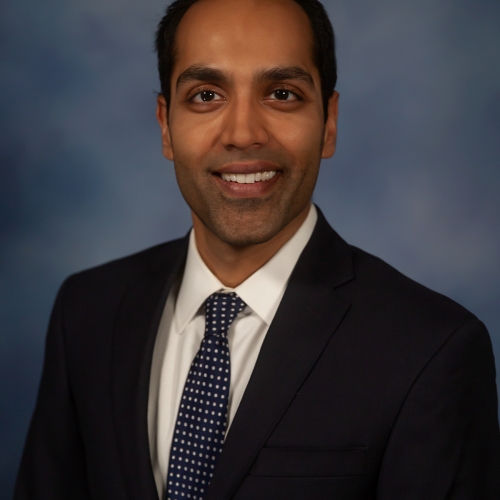
Available to mentor

-
FellowUniversity of Utah, Rhinology and Skull Base Surgery, 2022
-
ResidentUniversity of California, Davis, Otolaryngolgy, 2020
-
M.D.George Washington University, Washington D.C., 2015
-
B.S., Physiological SciencesUniversity of California, Los Angeles, Los Angeles, 2011
-
Center MemberRogel Cancer Center
-
Center MemberInstitute for Healthcare Policy and Innovation
I am a surgeon-scientist focused on developing targeted nanotherapeutic drug delivery systems for the upper airway to improve clinical outcomes in adults with chronic rhinosinusitis (CRS). During my otolaryngology residency, and, more recently, during a 2-year research focused fellowship at the University of Utah, I gained significant experience in patient-centered outcomes research within the field of CRS. I published over 40 papers focusing on CRS, and presented my findings nationally at biannual conferences over the last 3 years. During fellowship, I became acutely aware of the lack of innovation in medical management of CRS in the last 20 years. In part due to a strong collaboration between my fellowship director’s lab and drug delivery expert, Dr Ghandheri’s lab, I became passionate about identifying unique disease targets that could be targeted by nanotherapeutic technology to develop novel and more effective topical drug delivery systems. To this end, we published several papers assessing various targetable differences between disease and healthy sinonasal tissue, including a publication in Nanomedicine focusing on leveraging vascular dysregulation differences across these cohorts to improve drug tunability. Although my mentors were focused on optimizing systemic drug delivery, I became interested in improving topical delivery. At the end of fellowship, I characterized a novel sinonasal epithelial cell type previously only described in the Peyer’s patches of the human gut. This microfold cell has a unique apical membrane receptor known as glycoprotein 2 (GP2) receptor, which is utilized by the cell to bind and endocytose various antigens. The goal of the present proposal is to develop a targeted, nasal nanoparticle (NP) based drug delivery system that utilizes an anti-GP2 antibody conjugation to bind epithelial cell GP2 receptors and initiate endocytosis across the apical membrane. I aspire to become a national and international leader in targeted drug delivery within the upper airway and am fully committed to working with colleagues in otolaryngology, pulmonology, and drug delivery to improve outcomes for patients with CRS. From a clinical perspective, my goal is to continue to nurture a clinical practice focused on treating CRS, which, in turn, informs and inspires my translational basic science studies of sinonasal NP drug delivery. This K12 provides the critical training in advanced biochemical laboratory techniques, bioinformatics, and tenets of drug delivery necessary for comprehensively studying design and implementation of targeted drug delivery systems in upper airway disease.
-
Gill AS, Tullis B, Mace JC, Massey C, Pandrangi VC, Gutierrez JA, Ramakrishnan VR, Beswick DM, Soler ZM, Smith TL, Alt JA. Int Forum Allergy Rhinol, 2024 Aug; 14 (8): 1302 - 1313.Journal ArticleHealth care disparities and chronic rhinosinusitis: Does neighborhood disadvantage impact outcomes in sinonasal disease?
DOI:10.1002/alr.23337 PMID: 38367249 -
Tullis B, Mace JC, Hagedorn R, Nguyen C, Stockard R, Massey C, Ramakrishnan VR, Beswick DM, Soler ZM, Smith TL, Alt JA, Gill AS. Am J Rhinol Allergy, 2024 Jul; 38 (4): 237 - 244.Journal ArticleThe Impact of Acute Peri-operative Particulate Matter Exposure on Endoscopic Sinus Surgery Outcomes: A Preliminary Multi-site Investigation.
DOI:10.1177/19458924241246371 PMID: 38623645 -
Shipman PA, Yathavan B, Gill AS, Pollard CE, Yellepeddi V, Ghandehari H, Alt JA, Pulsipher A, Smith KA. Am J Rhinol Allergy, 2024 May; 38 (3): 169 - 177.Journal ArticleQuantification of Budesonide Retained in the Sinonasal Cavity After High-Volume Saline Irrigation in Post-Operative Chronic Rhinosinusitis.
DOI:10.1177/19458924241237839 PMID: 38456692 -
Asokumar D, Gill AS. Otolaryngol Clin North Am, 2024 Apr; 57 (2): 215 - 224.Journal ArticleAsthma Management Considerations for the Otolaryngologist: Current Therapies.
DOI:10.1016/j.otc.2023.10.001 PMID: 37923591 -
Batchu S, Gill AS, Karsy M. World Neurosurg, 2024 Mar; 183: e928 - e935.Journal ArticleCharacterizing Immune Infiltration in Esthesioneuroblastoma Subtypes Through Gene Expression Deconvolution.
DOI:10.1016/j.wneu.2024.01.063 PMID: 38246527 -
Dennis SK, Steele TO, Gill AS, Hwang JC, Sarhadi KS, Cheema KS, Aulakh SS, Wilson MD, Strong EB. Otolaryngol Head Neck Surg, 2023 Dec; 169 (6): 1455 - 1461.Journal ArticleTreatment Outcomes With Conservative Management of Frontal Sinus Outflow Tract Fractures.
DOI:10.1002/ohn.468 PMID: 37573490 -
Mulcahy L. 2023 Oct 31;Additional Scholarship4 Ways to Stop a Runny Nose that Actually Work: Easy ways to put the breakes on the sniffling
-
Virani FR, Wilson MD, Beliveau AM, Gill AS, Strong EB, Steele TO. Ear Nose Throat J, 2023 Oct; 102 (10): 654 - 660.Journal ArticleThe Impact of Surgical Posterior Nasal Nerve Cryoablation on Symptoms and Disease-Specific Quality of Life in Patients With Chronic Rhinitis.
DOI:10.1177/01455613211018576 PMID: 34128402